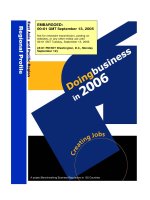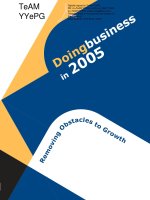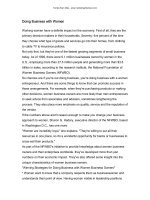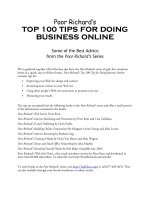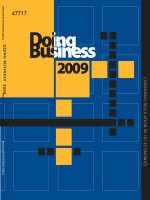doing business 2009
Bạn đang xem bản rút gọn của tài liệu. Xem và tải ngay bản đầy đủ của tài liệu tại đây (454.52 KB, 37 trang )
East Asia & Pacific
East Asia & Pacific
© 2008 The International Bank for Reconstruction and Development / The World Bank
1818 H Street NW
Washington, DC 20433
Telephone 202-473-1000
Internet
e-mail
All rights reserved.
1 2 3 4 08 07 06 05
A copublication of the World Bank and the International Finance Corporation.
This volume is a product of the staff of the World Bank Group. The findings, interpretations and conclusions expressed
in this volume do not necessarily reflect the views of the Executive Directors of The World Bank or the governments
they represent. The World Bank Group does not guarantee the accuracy of the data included in this work.
Rights and Permissions
The material in this publication is copyrighted. Copying and/or transmitting portions or all of this work without
permission may be a violation of applicable law. The World Bank Group encourages dissemination of its work and will
normally grant permission to reproduce portions of the work promptly.
For permission to photocopy or reprint any part of this work, please send a request with complete information to the
Copyright Clearance Center Inc., 222 Rosewood Drive, Danvers, MA 01923, USA; telephone: 978-750-8400; fax:
978-750-4470; Internet:
All other queries on rights and licenses, including subsidiary rights, should be addressed to the
Office of the Publisher, The World Bank
1818 H Street NW
Washington, DC 20433, USA
fax: 202-522-2422
e-mail:
Additional copies of Doing Business 2009, Doing Business 2008, Doing Business 2007 : How to Reform, Doing
Business in 2006 : Creating Jobs, Doing Business in 2005 : Removing Obstacles to Growth and Doing Business in
2004 : Understanding Regulations may be purchased at
ISBN: 978-0-8213-7609-6
E-ISBN: 978-0-8213-7610-2
DOI: 10.1596/978-0-8213-7609-6
www.doingbusiness.org
www.copyright.com
www.worldbank.org
Contents
Introduction
and Aggregate Rankings 1
Starting a Business 3
Dealing with
Construction Permits 6
Employing Workers 9
Registering Property 11
Getting Credit 14
Protecting Investors 17
Paying Taxes 19
Trading across Borders 22
Enforcing Contracts 26
Closing a Business 29
DB2009 Reforms 32
Current features
News on the Doing Business project
www.doingbusiness.org
Rankings
How economies rank-from 1 to 181
www.doingbusiness.org/economyrankings
Reformers
Short summaries of DB2009 reforms, lists of reformers since DB2004
and a ranking simulation tool
www.doingbusiness.org/reformers
Data time series
Customized data sets since DB2004
www.doingbusiness.org/customquery
Methodology and research
The methodologies and research papers underlying Doing Business
www.doingbusiness.org/MethodologySurveys
Blog
Online journal focusing on business regulation reform
Downloads
Doing Business reports as well as subnational, country and regional
reports and case studies
www.doingbusiness.org/downloads
Subnational projects
Differences in business regulations at the subnational level
www.doingbusiness.org/subnational
Law library
Online collection of business laws and regulations
www.doingbusiness.org/lawlibrary
Local partners
More than 6,700 specialists in 181 economies who participate
www.doingbusiness.org/LocalPartners
Reformers’ Club
Celebrating the top 10 Doing Business reformers
www.reformersclub.org
Business Planet
Interactive map on the ease of doing business
/>Doing Business 2009 is the sixth in a series of annual reports investigating regulations that enhance business
activity and those that constrain it. Doing Business presents quantitative indicators on business regulations and the
protection of property rights that can be compared across 181 economies, from Afghanistan to Zimbabwe, over
time.
A set of regulations affecting 10 stages of a business’s life are measured : starting a business, dealing with
construction permits, employing workers, registering property, getting credit, protecting investors, paying taxes,
trading across borders, enforcing contracts and closing a business. Data in Doing Business 2009 are current as of
June 1, 2008*. The indicators are used to analyze economic outcomes and identify what reforms have worked,
where, and why.
The Doing Business methodology has limitations. Other areas important to business such as an economy’s
proximity to large markets, the quality of its infrastructure services (other than those related to trading across
borders), the security of property from theft and looting, the transparency of government procurement,
macroeconomic conditions or the underlying strength of institutions, are not studied directly by Doing Business. To
make the data comparable across economies, the indicators refer to a specific type of business, generally a local
limited liability company operating in the largest business city. Because standard assumptions are used in the data
collection, comparisons and benchmarks are valid across economies. The data not only highlight the extent of
obstacles to doing business; they also help identify the source of those obstacles, supporting policymakers in
designing reform.
The data set covers 181 economies: 46 in Sub-Saharan Africa, 32 in Latin America and The Caribbean, 25 in
Eastern Europe and Central Asia, 24 in East Asia and Pacific, 19 in the Middle East and North Africa and 8 in
South Asia, as well as 27 OECD high-income economies as benchmarks. Some of the regions have been divided
into subregions to generate regional profiles.
The following pages present the summary Doing Business indicators for East Asia & Pacific. The data used for this
regional profile come from the Doing Business database and are summarized in graphs. These graphs allow a
comparison of the economies in each region not only with one another but also with the “good practice” economy
for each indicator.
The good-practice economies are identified by their position in each indicator as well as their overall ranking and
by their capacity to provide good examples of business regulation to other countries. These good -practice
economies do not necessarily rank number 1 in the topic or indicator, but they are in the top 10.
More information is available in the full report. Doing Business 2009 presents the indicators, analyzes their
relationship with economic outcomes and recommends reforms. The data, along with information on ordering the
report, are available on the Doing Business website (www.doingbusiness.org).
1
* Except for the Paying Taxes indicator that refers to the period January to December of 2007.
Economies are ranked on their ease of doing business, from 1 - 181, with first place being the highest. The
ease of doing business index averages the economy's percentile rankings on 10 topics, made up of a
variety of indicators, giving equal weight to each topic. The rankings are from the Doing Business 2009
report, covering the period June 2007 to June 2008.
East Asia & Pacific - Aggregate rankings
2
When entrepreneurs draw up a business plan and try to get under way, the first hurdles they face are the procedures
required to incorporate and register the new firm before they can legally operate. Economies differ greatly in how they
regulate the entry of new businesses. In some the process is straightforward and affordable. In others the procedures
are so burdensome that entrepreneurs may have to bribe officials to speed the process or may decide to run their
business informally.
The data on starting a business is based on a survey and research investigating the procedures that a standard small to
medium-size company needs to complete to start operations legally. These include obtaining all necessary permits and
licenses and completing all required inscriptions, verifications and notifications with authorities to enable the company
to formally operate. The time and cost required to complete each procedure under normal circumstances are
calculated, as well as the minimum capital that must be paid in. It is assumed that all information is readily available to
the entrepreneur, that there has been no prior contact with officials and that all government and nongovernment
entities involved in the process function without corruption.
To make the data comparable across economies, detailed assumptions about the type of business are used. Among
these assumptions are the following: the business is a limited liability company conducting general commercial
activities in the largest business city; it is 100% domestically owned, with a start-up capital of 10 times income per
capita, a turnover of at least 100 times income per capita and between 10 and 50 employees; and it does not qualify for
any special benefits, nor does it own real estate. Procedures are recorded only where interaction is required with an
external party. It is assumed that the founders complete all procedures themselves unless professional services (such as
by a notary or lawyer) are required by law. Voluntary procedures are not counted, nor are industry-specific
requirements and utility hook-ups. Lawful shortcuts are counted.
Cumbersome entry procedures are associated with more corruption, particularly in developing economies. Each
procedure is a point of contact, a potential opportunity to extract a bribe. Analysis shows that burdensome entry
regulations do not increase the quality of products, make work safer or reduce pollution. Instead, they constrain
private investment; push more people into the informal economy; increase consumer prices and fuel corruption.
3
Procedures to start a business
This graph compares the number of procedures required before an entrepreneur can operate a business. * The economy with the fewest procedures is
included as a benchmark. Starting a business also takes one step in Canada.
Time to start a business (days)
This graph compares the number of days required before an entrepreneur can operate its business.* The economy requiring the least time is included as
a benchmark.
4
Cost to start a business (% of income per capita)
This graph compares the costs to start a business. * The economy with the lowest cost is included as a benchmark.
Minimum capital to start a business (% of income per capita)
This graph compares the minimum capital an entrepreneur has to deposit before starting a business. * An economy with the lowest cost is included as a
benchmark. 69 economies do not have minimum capital requirements. These are listed on the Doing Business website.
5
Once entrepreneurs have registered a business, what regulations do they face in operating it? To measure such
regulation, Doing Business focuses on the construction sector. Construction companies are under constant pressure
from government to comply with inspections, with licensing and safety regulations, from customers to be quick and
cost-effective. These conflicting pressures point to the tradeoff in building regulation; the tradeoff between protecting
people (construction workers, tenants, passersby) and keeping the cost of building affordable.
In many economies, especially poor ones, complying with building regulations is so costly in time and money that
many builders opt out. Builders may pay bribes to pass inspections or simply build illegally, leading to hazardous
construction. In other economies compliance is simple, straightforward and inexpensive, yielding better results.
The indicators on dealing with construction permits record all procedures officially required for an entrepreneur in the
construction industry to build a warehouse. These include submitting project documents (building plans, site maps) to
the authorities, obtaining all necessary licenses and permits, completing all required notifications and receiving all
necessary inspections. They also include procedures for obtaining utility connections, such as electricity, telephone,
water and sewerage. The time and cost to complete each procedure under normal circumstances are calculated. All
official fees associated with legally completing the procedures are included. Time is recorded in calendar days. The
survey assumes that the entrepreneur is aware of all existing regulations and does not use an intermediary to complete
the procedures unless required to do so by law.
To make the data comparable across economies, several assumptions about the business and its operations are used.
The business is a small to medium-size limited liability company, located in the largest business city, domestically
owned and operated, in the construction business, with 20 qualified employees. The warehouse to be built:
• Is a new construction (there was no previous construction on the land).
• Has complete architectural and technical plans prepared by a licensed architect.
• Will be connected to electricity, water, sewerage (sewage system, septic tank or their equivalent) and one land phone
line. The connection to each utility network will be 32 feet, 10 inches (10 meters) long.
• Will be used for general storage, such as of books or stationery. The warehouse will not be used for any goods
requiring special conditions, such as food, chemicals or pharmaceuticals.
• Will take 30 weeks to construct (excluding all delays due to administrative and regulatory requirements).
Where the regulatory burden is large, entrepreneurs may tend to move their activity into the informal economy. There
they operate with less concern for safety, leaving everyone worse off.
6
Procedures to deal with construction permits
This graph compares the number of procedures required for an entrepreneur to deal with construction permits. * The economy with the fewest
procedures is included as a benchmark.
Time to deal with construction permits (days)
This graph compares the number of days required for an entrepreneur to deal with construction permits. * The economy requiring the least time is
included as a benchmark.
7
Cost to deal with construction permits (% of income per capita)
This graph compares the costs to deal with construction permits. * An economy with the lowest cost is included as a benchmark. Brunei, Qatar, Palau,
Trinidad and Tobago, St. Kitts and Nevis, and United Arab Emirates also require low costs.
8
Economies worldwide have established a system of laws and institutions intended to protect workers and guarantee a
minimum standard of living for its population. This system generally encompasses four bodies of law: employment,
industrial relations, social security and occupational health and safety laws. Doing Business examines government
regulation in the area of employment.
Two measures are presented: a rigidity of employment index and a firing cost measure. The rigidity of employment
index is the average of three subindices: difficulty of hiring, rigidity of hours and difficulty of firing. Each index takes
values between 0 and 100, with higher values indicating more rigid regulation. The difficulty of hiring index measures
the flexibility of contracts and the ratio of the minimum wage to the value added per worker. The rigidity of hours
index covers restrictions on weekend and night work, requirements relating to working time and the workweek, and
mandated days of annual leave with pay. The difficulty of firing index covers workers’ legal protections against
dismissal, including the grounds permitted for dismissal and procedures for dismissal (individual and collective):
notification and approval requirements, retraining or reassignment obligations and priority rules for dismissals and
reemployment.
The firing cost indicator measures the cost of advance notice requirements, severance payments and penalties due
when terminating a redundant worker, expressed in weeks of salary.
To make the data comparable across economies, a range of assumptions about the worker and the company are used.
The company is assumed to be a limited liability manufacturing corporation that operates in the economy’s most
populous city, is 100% domestically owned and has 201 employees. The company is also assumed to be subject to
collective bargaining agreements in economies where such agreements cover more than half the manufacturing sector
and apply even to firms not party to them.
Employment regulations are needed to allow efficient contracting between employers and workers and to protect
workers from discriminatory or unfair treatment by employers. In its indicators on employing workers, Doing Business
measures flexibility in the regulation of hiring, working hours and dismissal in a manner consistent with the
conventions of the International Labour Organization (ILO). An economy can have the most flexible labor regulations
as measured by Doing Business while ratifying and complying with all conventions directly relevant to the factors
measured by Doing Business and with the ILO core labor standards. No economy can achieve a better score by failing
to comply with these conventions.
Governments all over the world face the challenge of finding the right balance between worker protection and labor
market flexibility. But in developing countries especially, regulators often err to one extreme, pushing employers and
workers into the informal sector. Analysis across economies shows that while employment regulation generally
increases the tenure and wages of incumbent workers, overly rigid regulations may have undesirable side effects .
These include less job creation, smaller company size, less investment in research and development, and longer spells
of unemployment and thus the obsolescence of skills, all of which may reduce productivity growth. When economies
err on the side of excessive rigidity, it is to the detriment of businesses and workers alike.
9
Rigidity of employment index (0-100)
This graph compares the rigidity of employment index for an entrepreneur. * An economy with the lowest rigidity index is included as a benchmark.
Maldives, Marshall Islands, Singapore and the United States also have the lowest Rigidity of Employment Index.
Firing cost (weeks of salary)
This graph compares what an entrepreneur needs to pay in firing costs. The cost is measured in weeks of employee wages. * An economy requiring the
lowest cost is included as a benchmark. Afghanistan, Denmark, Iraq, Marshall Islands, Micronesia, Palau, Puerto Rico, Tonga and the United States
also have low firing costs.
10
Formal property titles help promote the transfer of land, encourage investment and give entrepreneurs access to formal
credit markets. But a large share of property in developing economies is not formally registered. Informal titles cannot
be used as security in obtaining loans, which limits financing opportunities for businesses. Many governments have
recognized this and started extensive property titling programs. But bringing assets into the formal sector is only part
of the story. The more difficult and costly it is to formally transfer property, the greater the chances that formalized
titles will quickly become informal again. Eliminating unnecessary obstacles to registering and transferring property is
therefore important for economic development.
Doing Business records the full sequence of procedures necessary for a business (buyer) to purchase a property from
another business (seller) and to transfer the property title to the buyer’s name. The property of land and building will
be transferred in its entirety. The transaction is considered complete when the buyer can use the property as collateral
for a bank loan.
Local property lawyers and officials in property registries provide information on required procedures as well as the
time and cost to complete each one. For most economies the data are based on responses from both. Based on the
responses, three indicators are constructed.
• Number of procedures to register property.
• Time to register property (in calendar days).
• Official costs to register property (as a percentage of the property value).
Many titling programs in Africa were futile because people bought and sold property informally, neglecting to update
the title records in the property registry. Why? Doing Business shows that completing a simple formal property
transfer in the largest business city of an African economy cost 10% of the value of the property and takes on average
90 days. Worse, the property registries are so poorly organized that they provide little security of ownership.
Efficient property registration reduces transaction costs and helps to formalize property titles. Simple procedures to
register property are also associated with greater perceived security of property rights and less corruption. That
benefits all entrepreneurs, especially women, the young and the poor. The rich have few problems protecting their
property rights. They can afford to invest in security systems and other measures to defend their property. But small
entrepreneurs cannot. Reform can change this. Twenty-four economies made it easier to register property in 2007/08.
The most popular reform: lowering the cost of registration by reducing the property transfer tax, registration fees or
stamp duty.
11
Procedures to register property
This graph compares the number of procedures required for an entrepreneur to register a property across economies. * An economy with the fewest
procedures is included as a benchmark. Sweden also has the fewest number of procedures to register a property.
Time to register property (days)
This graph compares the number of days required for an entrepreneur to register a property across economies. * An economy requiring the least time is
included as a benchmark. Saudi Arabia, Sweden and Thailand also have the least number of days to register property.
12
Cost to register property (% of property values)
This graph compares the costs to register a property. * The economy with the lowest cost is included as a benchmark.
13
Firms consistently rate access to credit as among the greatest barriers to their operation and growth. Doing Business
constructs two sets of indicators of how well credit markets function: one on credit registries and the other on legal
rights of borrowers and lenders. Credit registries, institutions that collect and distribute credit information on
borrowers, can greatly expand access to credit. By sharing credit information, they help lenders assess risk and
allocate credit more efficiently. And they free entrepreneurs from having to rely on personal connections alone when
trying to obtain credit. Three indicators are constructed to measure the sharing of credit information:
• Depth of credit information index, which measures the extent to which the rules of a credit information system
facilitate lending based on the scope of information distributed, the ease of access to information and the quality of
information.
• Public registry coverage, which reports the number of individuals and firms covered by a public credit registry as a
percentage of the adult population.
• Private bureau coverage, which reports the number of individuals and firms, covered by a private credit bureau as a
percentage of the adult population.
The strength of legal rights index measures the degree to which collateral and bankruptcy laws protect the rights of
borrowers and lenders and thus facilitate lending. This year, three main changes were made; first, a standardized case
scenario with specific assumptions was introduced to bring this indicator into line with other Doing Business
indicators. Second, the indicator now focuses not on tangible movable collateral, such as equipment, but on revolving
movable collateral, such as accounts receivable and inventory. Third, the indicator no longer considers whether
management remains in place during a reorganization procedure, better accommodating economies that adopt
reorganization procedures. The strength of legal rights index includes 8 aspects related to legal rights in collateral law
and 2 aspects in bankruptcy law:
• Any business may use movable assets as collateral while keeping possession of the assets, and any financial
institution may accept such assets as collateral.
• The law allows a business to grant a non possessory security right in a single category of revolving movable assets,
without requiring a specific description of the secured assets.
• The law allows a business to grant a non possessory security right in substantially all of its assets, without requiring a
specific description of the secured assets.
• A security right may extend to future or after-acquired assets and may extend automatically to the products, proceeds
or replacements of the original assets.
• General description of debts and obligations is permitted in collateral agreements and in registration documents, so
that all types of obligations and debts can be secured by stating a maximum rather than a specific amount between the
parties.
• A collateral registry is in operation that is unified geographically and by asset type and that is indexed by the name of
the grantor of a security right.
• Secured creditors are paid first when a debtor defaults outside an insolvency procedure or when a business is
liquidated.
• Secured creditors are not subject to an automatic stay or moratorium on enforcement procedures when a debtor
enters a court-supervised reorganization procedure.
• The law allows parties to agree in a collateral agreement that the lender may enforce its security right out of court.
14
Economy
Public registry
coverage
(% of adults)
Private bureau
coverage
(% of adults)
Depth of credit
information
index (0-6)
* New Zealand
5 0.0 100.0
* Portugal
4 76.4 11.3
* United Kingdom
6 0.0 100.0
Brunei
0 0.0 0.0
Cambodia
0 0.0 0.0
China
4 58.8 0.0
Fiji
4 0.0 42.3
Hong Kong, China
5 0.0 69.9
Indonesia
4 26.1 0.0
Kiribati
0 0.0 0.0
Lao PDR
0 0.0 0.0
Malaysia
6 52.9
Marshall Islands
0 0.0 0.0
Micronesia
0 0.0 0.0
Mongolia
3 22.7 0.0
Palau
0 0.0 0.0
Papua New Guinea
0 0.0 0.0
Philippines
3 0.0 5.4
Samoa
0 0.0 0.0
Singapore
4 0.0 48.3
Solomon Islands
0 0.0 0.0
Taiwan, China
5 0.0 62.7
Thailand
5 0.0 31.8
Timor-Leste
0 0.0 0.0
Tonga
0 0.0 0.0
Vanuatu
0 0.0 0.0
Vietnam
4 13.4 0.0
* The economies with the highest public, private bureau coverage and with the highest credit information index are included as
benchmarks. Argentina, Australia, Canada, Iceland, Ireland, Nicaragua, Norway, Sweden, United Kingdom and the United
States also have the highest private bureau coverage (% adults).
15
Strength of legal rights index (0-10)
This graph compares collateral and bankruptcy laws in the way they facilitate lending protecting the rights of borrowers and lenders as measured in the
legal rights Index. * An economy with the highest index is included as a benchmark. Kenya, Hong Kong China and Singapore have the highest Legal
Rights Index
16
Companies grow by raising capital, either through a bank loan or by attracting equity investors. Selling shares allows
companies to expand without the need to provide collateral and repay bank loans. But investors worry about their
money, and look for laws that protect them. A study finds that the presence of legal and regulatory protections for
investors explains up to 73% of the decision to invest. In contrast, company characteristics explain only between 4%
and 22%*. Good protections for minority shareholders are associated with larger and more active stock markets. Thus
both governments and businesses have an interest in reforms strengthening investor protections. To document some of
the protections investors have, Doing Business measures how economies regulate a standard case of self-dealing, use
of corporate assets for personal gain.
The case facts are straightforward. Mr. James, a director and the majority shareholder of a public company, proposes
that the company purchase used trucks from another company he owns. The price is higher than the going price for
used trucks. The transaction goes forward. All required approvals are obtained, and all required disclosures made,
though the transaction is prejudicial to the purchasing company. Shareholders sue the interested parties and the
members of the board of directors. Several questions arise. Who approves the transaction? What information must be
disclosed? What company documents can investors access? What do minority shareholders have to prove to get the
transaction stopped or to receive compensation from Mr. James? Three indices of investor protection are constructed
based on the answers to these and other questions. All indices range from 0 to 10, with higher values indicating more
protections or greater disclosure.
• The extent of disclosure index covers approval procedures, requirements for immediate disclosure to the public and
shareholders of proposed transactions, requirements for disclosure in periodic filings and reports and the availability
of external review of transactions before they take place.
• The extent of director liability index covers the ability of investors to hold Mr. James and the board of directors
liable for damages, the ability to rescind the transaction, the availability of fines and jail time associated with
self-dealing, the availability of direct or derivative suits and the ability to require Mr. James to pay back his personal
profits from the transaction.
• The ease of shareholder suits index covers the availability of documents that can be used during trial, the ability of
the investor to examine the defendant and other witnesses, shareholders’ access to internal documents of the company,
the appointment of an inspector to investigate the transaction and the standard of proof applicable to a civil suit
against the directors.
These three indices are averaged to create the strength of investor protection index. This index ranges from 0 to 10,
with higher values indicating better investor protection.
*Doidge, Kardyi and Stulz (2007)
17
Strength of investor protection index (0-10)
This graph compares the extent of disclosure, extent of director liability and ease of shareholder suits indices as measured in the Investor Protection
Index. * The economy with the highest index is included as a benchmark.
18
Taxes are essential. Without them there would be no money to provide public amenities, infrastructure and services
which are crucial for a properly functioning economy. But particularly for small and medium size companies, they
may opt out and choose to operate in the informal sector. One way to enhance tax compliance is to ease and simplify
the process of paying taxes for such businesses.
The Doing Business tax survey records the effective tax that a small and medium company must pay and the
administrative costs of doing so. Imagine a medium-size business, TaxpayerCo, that started operations last year. Doing
Business asks tax practitioners in 181 economies to review TaxpayerCo’s financial statements and a standard list of
transactions that the company completed during the year. Respondents are asked how much in taxes and mandatory
contributions the business must pay and what the process is for doing so.
The business starts from the same financial position in each economy. All the taxes and mandatory contributions paid
during the second year of operation are recorded. Taxes and mandatory contributions are measured at all levels of
government and include corporate income tax, turnover tax, all labor taxes and contributions paid by the company
(including mandatory contributions paid to private pension or insurance funds), property tax, property transfer tax,
dividend tax, capital gains tax, financial transactions tax, vehicle tax, sales tax and other small taxes (such as fuel tax,
stamp duty and local taxes). A range of standard deductions and exemptions are also recorded.
Three indicators are constructed:
• Number of tax payments, which takes into account the method of payment, the frequency of payments and the
number of agencies involved in our standardized case study.
• Time, which measures the number of hours per year necessary to prepare and file tax returns and to pay the corporate
income tax, value added tax, sales tax or goods and service tax and labor taxes and mandatory contributions.
• Total tax rate, which measures the amount of taxes and mandatory contributions payable by the company during the
second year of operation. This amount, expressed as a percentage of commercial profit, is the sum of all the different
taxes payable after accounting for various deductions and exemptions.
Businesses care about what they get for their taxes and contributions, such as the quality of infrastructure and social
services. Efficient tax systems tend to have less complex tax arrangements, comprising of straightforward compliance
procedures and clear laws. Taxpayers in such economies often get more from their taxes. Simple, moderate taxes and
fast, cheap administration mean less hassle for businesses, and also more revenue collected and better public services.
More burdensome tax regimes create an incentive to evade taxes.
19
Payments (number per year)
This graph compares the number of payments required for an entrepreneur to pay taxes. * An economy requiring the least number of payments is
included as a benchmark. Qatar and Maldives also require the fewest number of payments to pay taxes.
Time to pay taxes (hours per year)
This graph compares the time in hours required for an entrepreneur to pay taxes. * An economy with low time is included as a benchmark. Bahamas,
Bahrain, Qatar, Maldives, United Arab Emirates also have one of the lowest time to pay taxes.
20
Total tax rate (% of profit)
This graph compares the total tax rate that an entrepreneur is required to pay as a percentage of profit. * The economy with the lowest tax rate is
included as a benchmark.
21
The benefits of trade are well documented; as are the obstacles to trade. Tariffs, quotas and distance from large
markets greatly increase the cost of goods or prevent trading altogether. But with bigger ships and faster planes, the
world is shrinking. Global and regional trade agreements have reduced trade barriers. Yet Africa’s share of global
trade is smaller today than it was 25 years ago. So is the Middle East’s, excluding oil exports. Many entrepreneurs
face numerous hurdles to exporting or importing goods, including delays at the border. They often give up. Others
never try. In fact, the potential gains from trade facilitation may be greater than those arising from only tariff
reductions.
Doing Business compiles procedural requirements for trading a standard shipment of goods by ocean transport. Every
procedure and the associated documents, time and cost, for importing and exporting the goods is recorded, starting
with the contractual agreement between the two parties and ending with delivery of the goods. For importing the
goods, the procedures measured range from the vessel’s arrival at the port of entry to the shipment’s delivery at the
importer’s warehouse. For exporting the goods, the procedures measured range from the packing of the goods at the
factory to their departure from the port of exit. Payment is by letter of credit and the time and cost for issuing or
securing a letter of credit is taken into account.
To make the data comparable across countries, several assumptions about the business and the traded goods are used.
The business is of medium size, employs 60 people, and is located in the periurban area of the economy’s most
populous city. It is a private, limited liability company, domestically owned, formally registered and operating under
commercial laws and regulations of the economy. The traded goods are ordinary, legally manufactured products
transported in a dry-cargo, 20-foot FCL (full container load) container.
Documents recorded include port filing documents, customs declaration and clearance documents, as well as official
documents exchanged between the parties to the transaction. Time is recorded in calendar days, from the beginning to
the end of each procedure. Cost includes the fees levied on a 20-foot container in U.S. dollars. All the fees associated
with completing the procedures to export or import the goods are included, such as costs for documents,
administrative fees for customs clearance and technical control, terminal handling charges and inland transport. The
cost measure does not include tariffs or duties.
Economies that have efficient customs, good transport networks and fewer document requirements, making
compliance with export and import procedures faster and cheaper, are more competitive globally. That can lead to
more exports; and exports are associated with faster growth and more jobs. Conversely, a need to file many documents
is associated with more corruption in customs. Faced with long delays and frequent demands for bribes, many traders
may avoid customs altogether. Instead, they smuggle goods across the border. This defeats the very purpose in having
border control of trade to levy taxes and ensure high quality of goods.
22
